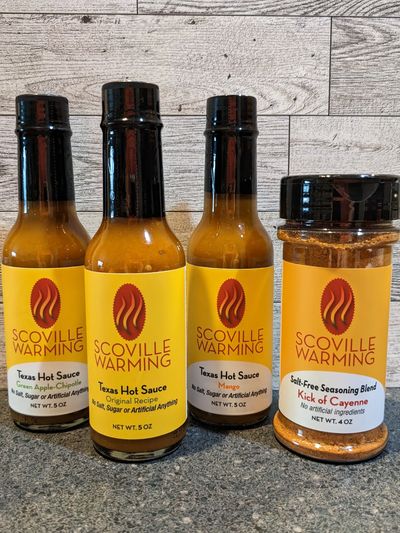Salt-free, sugar-free hot sauces & seasoning
HOW HOT IS IT?

Our Scoville Ratings
All Scoville Warming products are in the mild-to-medium heat range, all coming in at less than 3,000 Scoville Heat Units (SHU). Our Original Recipe Texas Hot Sauce is the hottest of the three sauces, with Green Apple Chipotle and Mango slightly milder.
We use fresh natural ingredients - no mash, extracts or artificial flavoring. All Scoville Warming products are salt-free, sugar-free and gluten-free. Our fans who have dietary restrictions tell us they appreciate the clean ingredients and taste.
- Scoville Warming Original Recipe is comparable in heat but much thicker than Tapatío® brand, (3000 SHU) which contains red peppers, water, salt, garlic and spices.
- Unlike the well-known Sriracha sauce with a rooster on the label, Scoville Warming hot sauce has no jalapeno peppers, no potassium sorbate, sodium bisulfite or xanthan gum, salt or sugar.
- Scoville Warming is milder than TABASCO® Brand Habanero Pepper Sauce (7000+), which lists cane sugar and salt among its ingredients.
Thank you, Wilbur Scoville
Inventor of the Scoville Scale
Chile-heads and hot pepper enthusiasts will appreciate our nod to pharmacist Wilbur Lincoln Scoville. Back in 1912, Dr. Scoville developed a scale to measure the relative heat of a chile pepper. Known as the Scoville Scale or the Scoville Heat Index, it's one of the methods used to figure out how hot or mild a pepper tastes.
The habanero peppers we use in Scoville Warming are far hotter than a jalapeno pepper but nowhere near the Bhut Jolokia (ghost pepper), Trinidad Scorpion or Carolina Reaper because we’re not into pain. We add milder peppers and carrots to temper the habaneros’ fire. We want you to taste the flavor first. Then the warmth kinda sneaks up on you. You're welcome.
According to Chile Pepper Institute experts, the heat level of a chile pepper is expressed in Scoville Heat Units (SHU). The measurement is intended for comparison only, because heat levels can fluctuate greatly from location, and even from pod to pod on the same plant.


